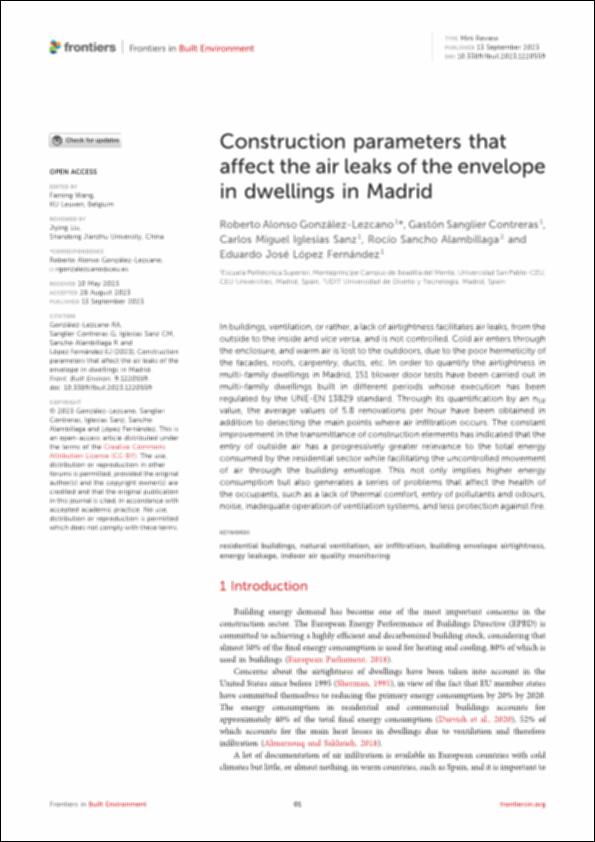Please use this identifier to cite or link to this item:
http://hdl.handle.net/10637/14664Construction parameters that affect the air leaks of the envelope in dwellings in Madrid
| Title: | Construction parameters that affect the air leaks of the envelope in dwellings in Madrid |
| Authors : | González Lezcano, Roberto Alonso. Sanglier Contreras, Gastón Iglesias Sanz, Carlos Miguel López Fernández, Eduardo José |
| Keywords: | Residential buildings; Natural ventilation; Air infiltration; Building envelope airtightness; Energy leakage; Indoor air quality monitoring |
| Publisher: | Frontiers Media |
| Citation: | González-Lezcano RA, Sanglier Contreras G, Iglesias Sanz CM, Sancho Alambillaga R and López Fernández EJ (2023), Construction parameters that affect the air leaks of the envelope in dwellings in Madrid. Front. Built Environ. 9:1220559. doi: 10.3389/fbuil.2023.1220559 |
| Abstract: | In buildings, ventilation, or rather, a lack of airtightness facilitates air leaks, from the outside to the inside and vice versa, and is not controlled. Cold air enters through the enclosure, and warm air is lost to the outdoors, due to the poor hermeticity of the facades, roofs, carpentry, ducts, etc. In order to quantify the airtightness in multi-family dwellings in Madrid, 151 blower door tests have been carried out in multi-family dwellings built in different periods whose execution has been regulated by the UNE-EN 13829 standard. Through its quantification by an n50 value, the average values of 5.8 renovations per hour have been obtained in addition to detecting the main points where air infiltration occurs. The constant improvement in the transmittance of construction elements has indicated that the entry of outside air has a progressively greater relevance to the total energy consumed by the residential sector while facilitating the uncontrolled movement of air through the building envelope. This not only implies higher energy consumption but also generates a series of problems that affect the health of the occupants, such as a lack of thermal comfort, entry of pollutants and odours, noise, inadequate operation of ventilation systems, and less protection against fire. |
| URI: | http://hdl.handle.net/10637/14664 |
| Rights : | http://creativecommons.org/licenses/by-nc-nd/4.0/deed.es OpenAccess |
| ISSN: | 2297-3362 |
| Issue Date: | 13-Sep-2023 |
| Center : | Universidad San Pablo-CEU |
| Appears in Collections: | Escuela de Politécnica Superior |
Items in DSpace are protected by copyright, with all rights reserved, unless otherwise indicated.


